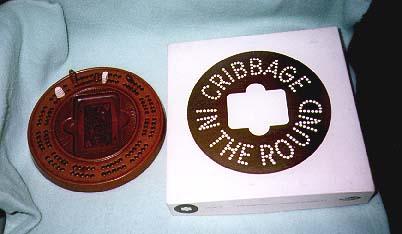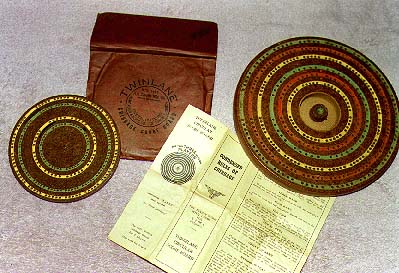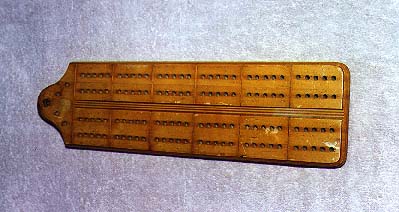♠ Article Library ♦ Board Gallery
In the last article I referenced a former manufacturer of cribbage boards about whom we had little historical data until recently. Unraveling the history of manufacturers and the identification of the manufacturers of boards is a time-consuming project, as I have stated before. It is, however, the true collector's challenge, and one that brings great satisfaction when the mystery surrounding an unidentified board is solved. One member of the CBCS, Tom O'Gara, who is known as the super collector of cribbage boards, has unraveled many of the mysteries surrounding our boards. Tom lives in the rich antiquing belt of central Massachusetts, and is privy to the Brimfield Marts as well as many flea markets and antique stores. All the dealers seem to know him, as I learned at the last Brimfield extravaganza, for I was told by more than one when I asked if they had any cribbage boards - "No, I save them for a dedicated collector and wouldn't dare sell them to anyone else!"
Several years ago, Tom brought three round cribbage boards to me for review. They were colorful and looked quite compatible as a grouping. The identity of their origin, however, was unknown, but all three boards appeared to be manufactured. I took a photo of the three boards, and eventually it landed in the files under the "unidentified" section. The photo sat there for the past three years, collecting dust from disuse - until recently. Through sheer circumstance, the identity of two of the three boards' manufacturers have surfaced, both within a month of each other!

This round cribbage board appears to be made of a molded composition product, has a smooth finish and is a rich brown color. The center of the board is recessed to hold a deck of cards, and impressed in the recessed area is a Jack of Hearts. The playing field is 2P (two player), T.A. (Twice around) and is located around the outer edge of the board.
Tom was scouting the region one day recently, when he happened to run across his Jack of Hearts board in
a box marked Cribbage in the Round. Included with the board and box were the pegs, which are brown and
ivory color and have a flattened scrolled top. They are made of the same material as the board. The board
was manufactured in 1966 by ALPSCO of Locust Valley, NY, and is identified as item No. 40.

This board remains unidentified, and the CBCS would appreciate receiving any information that the viewers may have regarding it.

Recently, when my brother Bob and his wife were preparing to move, Angela came across a small packaged board which had belonged to her father. At the time, it was of little significance to her, but she felt that I might like it for my collection. Upon presentation to me, I was stunned by the similarity of the board to the unidentified round Masonite board already housed in my collection which Tom had given me. Angela's board was still housed in its' original foil-lined folder, and the directions were intact! The board is a 2P (two player) once-around the outer and inner tracks, tracks of two colors, the rest of the board being brown. The foil-lined folder was marked with the name of the manufacturer and the firm for whom this board, which is an advertising board, was manufactured. The board itself is also stamped on the underside with all the information as well. The board is called "Twinlane" and was manufactured by Acme Ruler and Advertising Co., LTD., of Toronto Canada. Acme Ruler, by the way, was responsible for many of the fine boards manufactured in Canada in the 1940's and 1950's and frequently used the popular Brooks-style track on their boards. The next step was to review the directions, and one quick glance revealed a picture of our previously unidentified three player board, identified as a "Threelane Circular Score Board". The small board is nicely identified with all the significant data, whereas the three player board had no identifying information. Thanks to my sister-in-law, who is not a collector of boards, the mystery of another board is resolved!

Here is a great playable 2P, T.A. board, whose history has successfully eluded us to this point. Many of the boards are still in existence and can be found in three versions, all exactly the same size and edging. The holes on all three boards are drilled straight through, and the sets of double 5 holes are separated by fine diagonal inlays. The boards all use a 2-peg, more commonly known as a "Club" peg. There is a hole drilled at the top center to allow for wall display and two peg-out holes on either side of it. There is no question as to the fact that the boards were manufactured - but by whom?
The board pictured is made of two different kinds of wood bonded together (front & back). The bonding has held so well over the years, that it was difficult for me to determine whether they were bonded woods or whether two different stains were used to create the effect on the two boards that I examined. They are definitely bonded. Both sides of the board are grooved down the center and there is peg storage on the outer upper edge. The second board does not have the grooving down the center and it is made of a single piece of wood.
The third example also lacks the center grooving and is made of a single piece of wood. It differs from
model number two in that it also lacks the upper outer holes for peg storage. Quite possible this was the
original model, with the three boards showing the progressive improvements in manufacture.
This board has been around for a long time and is even referenced in a book called "What's New That's Old",
written by John Mebane. It is in this book that the board is called a "City Club Board", and I am curious
as to how it received that name. The grooved board is pictured, and there is no reference to the other two
styles.
In summary, the mystery of the City Club Board will be resolved eventually, and it will probably happen without fanfare.